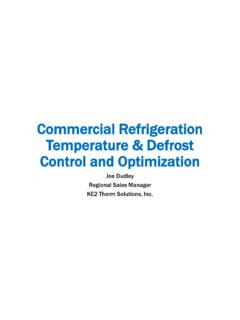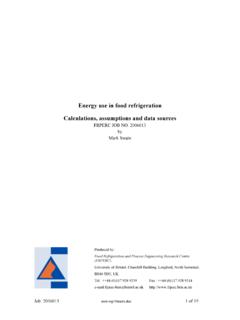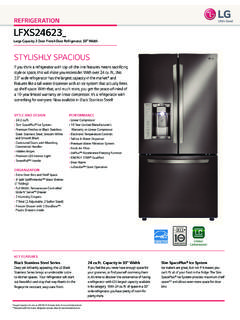Transcription of ACCIDENT PREVENTION AND RESPONSE MANUAL
1 ACCIDENT PREVENTION AND RESPONSE MANUAL For Anhydrous ammonia refrigeration System Operators Environmental Protection Agency Region 7 June 2015 (Fourth Edition) EPA-907-B-1-9001 What s this MANUAL All About? There are many laws and regulations in place to protect operators, other employees, and surrounding communities from the potential hazards of working with toxic chemicals like anhydrous ammonia . This MANUAL summarizes the requirements of environmental and safety laws for anhydrous ammonia refrigeration system operators. A list of the federal laws and regulations related to process safety, ACCIDENT PREVENTION , emergency planning, and release reporting may be found in Appendix C.
2 Many anhydrous ammonia system operators know their systems inside and out. If you are already familiar with the environmental laws and regulations that pertain to your system, then you are invited to test your knowledge by taking the quiz in Appendix E. If you score 100% - CONGRATULATIONS and you may not need this MANUAL . If you score less than 100%, this MANUAL will help you update your knowledge base. Good luck! Test your ammonia refrigeration knowledge in Appendix E. This MANUAL has been prepared by the Environmental Protection Agency Region 7 (Iowa, Kansas, Missouri & Nebraska). Region 7 thanks all who contributed their time and expertise to the development of this MANUAL .
3 A special thanks to the final editor, Patricia Reitz, of EPA Region 7. Notes about this Fourth Edition: The third edition was published March 2006. Since then several new recognized and generally accepted good engineering practices (RAGAGEPS) have been embraced as industry standards. This fourth edition is updated to reflect these new standards. Disclaimers: This MANUAL provides guidance to assist regulated entities in understanding their obligations in accordance with environmental laws. For a complete understanding of all legal requirements, the reader must refer to applicable federal and state statutes and regulations. This MANUAL is not a substitute for regulations, nor is it a regulation itself.
4 Thus, it cannot impose legally binding requirements of EPA, states, or the regulated community. This guidance does not represent final agency action and may change in the future, as appropriate. This guidance does not limit the otherwise lawful prerogatives of regulating agencies. Agencies may act at variance with this guidance based on facility specific circumstances. Mention of trade names, commercial products, industry references, and technical resources does not constitute an endorsement or recommendation for use. Table of Contents CHAPTER 1 WHAT S THE BIG EMERGENCY? .. Accidents Happen .. Why is Anhydrous ammonia so Dangerous? .. CHAPTER 2 IS MY FACILITY A SAFETY RISK?
5 Determine Your Responsibility .. OSHA Requirements .. EPA Requirements .. DHS Requirements .. CHAPTER 3 PREVENTING ACCIDENTS .. Work Safely .. Worker and System Protection .. System Operations and Maintenance .. System Inspections .. Training .. Property Security .. Other RAGAGEP .. CHAPTER 4 WHAT TO DO WHEN THERE IS AN ACCIDENT .. Be Prepared .. Report the ACCIDENT .. Investigations .. APPENDIX A CLEAN AIR ACT (CAA) PREVENTION PROGRAM REQUIREMENTS .. Risk Management Program Level .. Program 3 Requirements .. Management System .. Hazard Assessment .. PREVENTION Program .. Emergency RESPONSE .
6 Risk Management Plan .. Compliance .. Deregistration .. APPENDIX B EMERGENCY PLANNING .. Emergency RESPONSE Planning .. Emergency RESPONSE Program .. Emergency RESPONSE Plan (ERP).. Emergency RESPONSE Equipment .. Train All Review and Update ERP .. Practice Your Plan .. B. 5 Emergency Planning and RESPONSE Guidance .. APPENDIX C GOVERNMENT REQUIREMENTS .. Federal Requirements .. State and Local Requirements .. APPENDIX D EDUCATION AND INFORMATION RESOURCES .. APPENDIX E ANHYDROUS ammonia HANDLING QUIZ .. ACCIDENT PREVENTION and RESPONSE MANUAL for Anhydrous ammonia refrigeration System Operators Environmental Protection Agency Region 7 CHAPTER 1 WHAT S THE BIG EMERGENCY?
7 Page CHAPTER 1 WHAT S THE BIG EMERGENCY? Accidents Happen ammonia is used as a refrigerant at a large number of industrial facilities, such as: Cold storage warehouses and ice plants, Meat, poultry, or fish processing plants, Dairy and ice cream plants, Wineries and breweries, Fruit/vegetable juice and soft drink processing facilities, and Chemical manufacturing facilities Accidental ammonia releases cause injuries and death to employees, emergency RESPONSE personnel, and people in surrounding communities. Here are some examples: Seven in Intensive Care Following ammonia Leak In March 2011, a poultry plant in Alabama accidently released 32,000 pounds of anhydrous ammonia resulting in $4 million in product losses.
8 Approximately 150 people were taken to the hospital. The leak prompted road closures and the evacuation of workers and neighboring residents. Factors contributing to the ACCIDENT include an early termination to the defrost cycle causing hydraulic thermal shock, too many evaporators going into defrost at the same time, and equipment and operator error. Two Workers Killed in Cold Storage ACCIDENT In May 2009, a leak of anhydrous ammonia killed 2 maintenance workers at a cold storage facility in Kentucky. Plant employees described the vapors as too thick to see through. Thirty-Two Hospitalized after Rupture of refrigeration Piping In August 2010, 32 offsite workers were hospitalized after a cold storage facility in Alabama released more than 32,000 pounds of anhydrous ammonia .
9 The refrigeration system experienced a sudden, localized pressure surge called hydraulic shock , causing catastrophic failure of piping, valves, and other system components. 72% of all reported chemical accidents in Iowa, Kansas, Missouri, and Nebraska involve anhydrous ammonia . Up to 96% of them are preventable through increased operator training, improved procedures, and better communication of lessons learned. (Based on chemical accidents required by EPA to be reported by industry from 2004-2014.) ACCIDENT PREVENTION and RESPONSE MANUAL for Anhydrous ammonia refrigeration System Operators Environmental Protection Agency Region 7 CHAPTER 1 WHAT S THE BIG EMERGENCY?
10 Page Why Is Anhydrous ammonia So Dangerous? Anhydrous ammonia and ammonium hydroxide are two types of ammonia commonly used in industry. This MANUAL will focus on the anhydrous type, which means, without water. (Ammonium hydroxide is formed when ammonia gas is dissolved in water.) Anhydrous ammonia is very corrosive, and exposure to it may result in chemical-type burns to skin, eyes, and lungs. It may also result in frostbite, since its boiling point is -28 F. ammonia is hygroscopic, which means it has a high affinity for water, and migrates to moist areas like the eyes, nose, mouth, throat, and moist skin. Released anhydrous ammonia will rapidly absorb moisture from air and form a dense, visible white cloud.















